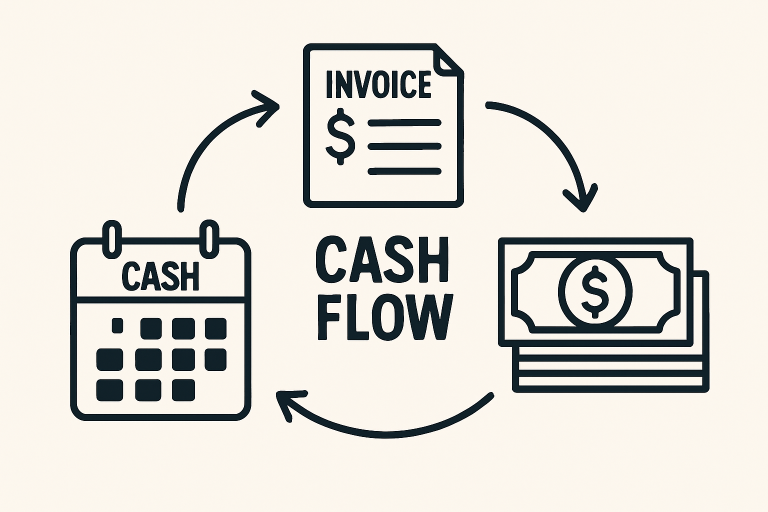Key Takeaways
- Accurate cash flow forecasting enables proactive financial planning.
- Streamlining accounts receivable processes accelerates cash inflows.
- Optimizing accounts payable practices preserves cash reserves.
- Efficient inventory management frees up working capital.
- Leveraging short-term financing options can bridge temporary cash gaps.
Introduction
In today’s fast-paced business environment, keeping a close eye on short-term cash flow is more critical than ever. Whether you’re a small startup or a growing enterprise, having effective strategies in place can mean the difference between seizing new opportunities and facing financial roadblocks. For many businesses, this includes using reliable external partners like MaxLend for convenient short-term financing that helps bridge any immediate gaps.
Adopting a disciplined approach to cash management—from forecasting and receivables to financial automation—can protect your business’s stability and ensure continued growth. Below, we explore actionable strategies for managing short-term cash flow and maintaining financial health.
Accurate Cash Flow Forecasting
Forecasting is the cornerstone of effective cash flow management. By projecting income and expenses over coming weeks or months, businesses can foresee potential cash shortages and plan accordingly. This proactive step enables decision-makers to balance expenditure, delay non-essential purchases, or negotiate payment terms in advance. Accounting software or dedicated forecasting tools give more accurate insights by updating projections with the latest data.
Best Practices for Forecasting
- Establish a regular updating schedule—weekly or monthly is ideal.
- Incorporate actual inflows and outflows for data-driven accuracy.
- Consult historical financials to detect seasonal fluctuations or trends.
- Remain conservative with revenue estimates to avoid overspending.
Streamlining Accounts Receivable
One of the fastest ways to boost cash flow is by accelerating accounts receivable. Efficient collection processes allow you to reduce the time between selling goods or services and having cash in hand. To achieve this, businesses should create clear invoice terms and issue invoices immediately after delivering goods or services. Consider automation tools that send reminders when payments are due and alert you to overdue accounts—helping you stay on top of collection efforts.

Incentivizing Prompt Payment
- Offer early payment discounts as a motivator for clients.
- Communicate penalties for late payments upfront and enforce them consistently.
- Make payment as easy as possible by providing multiple payment options.
Optimizing Accounts Payable
While collecting payments quickly is necessary, businesses also benefit from slowing down outgoing payments—provided this is done strategically. By negotiating extended payment terms with suppliers and only paying invoices when due, you keep cash available for other critical needs. Managing Days Payable Outstanding (DPO) is a key performance indicator: optimizing this ratio preserves liquidity and strengthens vendor relationships.
Strategies for Optimization
- Consolidate vendor buying to strengthen negotiating power for terms.
- Regularly review payment schedules to avoid missed discounts or late penalties.
- Leverage digital solutions to automate invoice approval and scheduling.
Efficient Inventory Management
Excess inventory ties up valuable cash that could be better used elsewhere. Carrying only what you need lowers storage costs and keeps working capital flexible. To accomplish this, audit inventory regularly and use demand forecasting techniques to avoid over-purchasing. Negotiate with key suppliers for flexible restocking terms, and consider adopting just-in-time inventory systems when possible.
Inventory Management Tactics
- Monitor sell-through rates and adjust reordering patterns accordingly.
- Liquidate obsolete or slow-moving stock to free up cash.
- Utilize inventory management software for better accuracy and visibility.
Leveraging Short-Term Financing
Cash flow interruptions can occur unexpectedly due to sudden expenses or seasonal revenue slowdowns. Short-term financing—like lines of credit, merchant cash advances, or a MaxLend loan—can provide the necessary support when used wisely. These solutions offer fast access to funds, often through a simple apply online process, making them convenient for business owners in urgent need. However, borrowing with a clear repayment strategy and specific business purpose is essential to avoid incurring unnecessary debt and ensure long-term financial stability.
Responsible Borrowing Tips
- Understand loan terms, including interest rates and fees.
- Choose financing with flexible repayment options.
- Borrow only what’s necessary for the gap you need to fill.
Implementing Automation in Financial Operations
Automation solutions are transforming the way businesses manage cash flow. By reducing manual work, automation decreases the chance of administrative error and speeds up processes like payment tracking, invoicing, and reporting. Real-time dashboards can update cash positions and flag inconsistencies, allowing you to address potential issues before they escalate.
Popular Automation Tools
- Automated invoicing platforms streamline billing and follow-ups.
- Expense management software tightens cost control.
- Integrated dashboards offer a holistic view of current and projected cash flow.
Building and Maintaining a Cash Reserve
Establishing a cash buffer is essential for weathering unforeseen expenses or revenue delays. Start by setting a realistic reserve target—such as covering one or two months of operating costs—and gradually allocate surplus funds to this account. A structured reserve prevents emergency borrowing and offers peace of mind during volatile periods.
Steps for Sustaining a Reserve
- Automate regular transfers into your cash reserve account.
- Review reserve levels quarterly to ensure they reflect current needs.
- Avoid dipping into reserves for anything other than true emergencies.
By combining thoughtful cash flow forecasting, optimized processes, and prudent financial tools, businesses can enhance liquidity, minimize risk, and position themselves for stability and sustainable growth.

